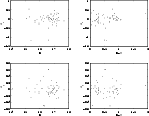 |
Figure 1: Plate CL 58004: residuals in X and Y vs. mag and color |
In the reduction we checked the need for different plate constants.
It is shown that six plate constants would be enough
for our central overlap procedure. Thus, higher order polynomials of the
positions and
additional magnitude and color terms were not necessary. Figure 1
gives the residuals in x and y with respect to magnitude and
color, respectively, for plate CL 58004 (here we selected only
stars which were seen on at least two of the first epoch plates),
Fig. 2
gives the same relations for CCD frame 25m4147b30f. Both figures
show no significant systematic trend. From these two figures one
can find that the positional accuracy of the CCD frames is about
0
![]() 13, which is consistent with our estimation above, while
the positional accuracy for photographic plates is about 0
13, which is consistent with our estimation above, while
the positional accuracy for photographic plates is about 0
![]() 20
(after rejecting several stars with large deviations).
20
(after rejecting several stars with large deviations).
After the fourth iteration positions and proper motions from two
subsequent iteration steps showed little deviations. Mean
differences in position were smaller than 0
![]() 03,
the rms is smaller than 6 mas and the differences in proper motion
were below 1 mas/yr, the rms below 0.15 mas/yr. We took the positions
and proper motions of 115 stars given by this iteration as the
final outcome and their errors are listed in Table 6. It should be
pointed out that the errors given in Table 6 are only estimates of
internal errors in the adjustment process and are
undoubtedly underestimated to some extent. In our following
discussion on the membership probabilities, we shall give more
realistic error estimates.
03,
the rms is smaller than 6 mas and the differences in proper motion
were below 1 mas/yr, the rms below 0.15 mas/yr. We took the positions
and proper motions of 115 stars given by this iteration as the
final outcome and their errors are listed in Table 6. It should be
pointed out that the errors given in Table 6 are only estimates of
internal errors in the adjustment process and are
undoubtedly underestimated to some extent. In our following
discussion on the membership probabilities, we shall give more
realistic error estimates.
| Parameter | Median error | Maximum error |
|
|
|
|
|
|
|
|
|
|
1.45 mas/yr | 15.13 mas/yr |
|
|
1.39 mas/yr | 11.88 mas/yr |
To search for possible systematic errors in our resulting proper motions, we selected a test sample of 34 stars with membership probabilities greater than 0.7 and of horizontal branch or the giant branch nature from the V versus (V-I) diagram (see Fig. 6 and text below). From this sample, the resulting proper motions were plotted against R.A., DEC., V and V-I, respectively, as is shown in Fig. 3 and Fig. 4. No apparent systematic dependence could be found in these figures. However, as is seen in these figures, the proper motion dispersions are much greater than the internal errors in Table 6. The proper motion dispersions here are 2.7 mas/yr in right ascension and 3.2 mas/yr in declination, respectively, which should be related to the astrometric accuracy of the CCD frames and the photographic plates. For those stars which are seen on all three plates and four CCD frames, the accuracy is rather 3 mas/yr.
For the membership probability estimation, we used a maximum
likelihood method with a 9-parameter Gaussian model as follows:
![\begin{eqnarray*}\Phi(\mu_{xi},\mu_{yi}) & {=} & \Phi_{\rm c}(\mu_{xi},\mu_{yi})...
...yf})^{2}}{\sigma^{2}_{y0}+\varepsilon^{2}_{yi}}\right]\right\}.
\end{eqnarray*}](/articles/aas/full/2000/06/h1532/img32.gif)
| Parameter | Estimate |
|
|
-1.65 |
|
|
-2.69 |
|
|
-5.30 |
|
|
-4.13 |
|
|
2.58 |
|
|
12.69 |
|
|
11.52 |
| -0.105 |
|
| 0.698 |
|
| Prob. | Number of stars |
| 1.00-0.90 | 59 |
| 0.90-0.80 | 16 |
| 0.80-0.70 | 6 |
| 0.70-0.60 | 2 |
| 0.60-0.50 | 2 |
| 0.50-0.40 | 2 |
| 0.40-0.30 | 1 |
| 0.30-0.20 | 2 |
| 0.20-0.10 | 3 |
| 0.10-0.01 | 3 |
| 0.00 | 19 |
The values in Table 7 provide a possibility of estimating the
external accuracy of the proper motion results in this work. Since
NGC 4147 is very far away from us the contribution by the internal
motions of the cluster stars can be neglected and
![]() can
be regarded entirely as the observational dispersion. The dispersion
of 2.6 mas/yr is in good agreement with the error estimated from
the astrometric accuracy of the CCD frames and the plates.
can
be regarded entirely as the observational dispersion. The dispersion
of 2.6 mas/yr is in good agreement with the error estimated from
the astrometric accuracy of the CCD frames and the plates.
Copyright The European Southern Observatory (ESO)